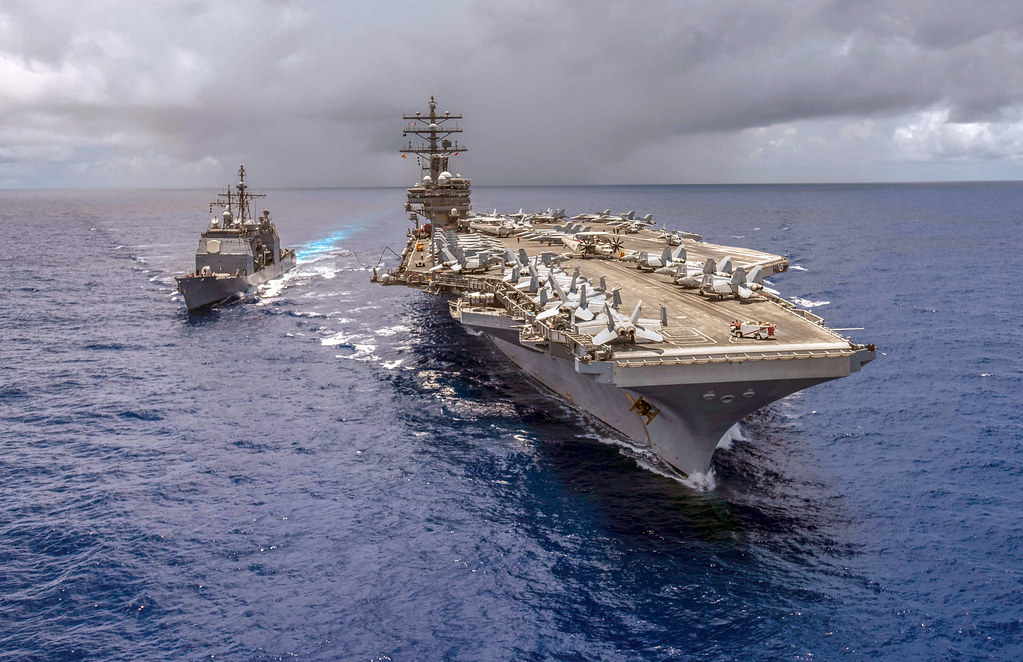
As the USS Ronald Reagan, a formidable Nimitz-class aircraft carrier, bid farewell to Japan, a strategic shift underscored America’s steadfast dedication to preserving stability.

The carrier’s departure from its homeport in Yokosuka marks the end of nearly a decade-long forward deployment, a period characterized by deepening defense ties with Japan and a palpable presence in a geopolitically tense theatre.

“After nine years of deployment to Japan, the USS Ronald Reagan and her 6,000 crew deserve our heartfelt appreciation for their selflessness, their service, and their sacrifice in keeping the Indo-Pacific safe, secure, and stable,” U.S. Ambassador to Japan Rahm Emanuel eloquently stated during the departure ceremony.

Since its arrival in 2015, the USS Ronald Reagan has embodied U.S. military might and commitment to international law and a free and open Indo-Pacific.

As the flagship of the U.S. Navy’s 7th Fleet’s Carrier Strike Group 5, the Reagan has conducted numerous multilateral exercises and engaged in pivotal operations, including humanitarian assistance following Japan’s devastating earthquake and tsunami in 2011 and supporting U.S. withdrawal efforts in Afghanistan in 2021.

Emanuel’s tribute to the sailors as “America’s true 1 percent” encapsulates the high regard held for those who contribute significantly to broader security goals. The Reagan’s tenure has facilitated closer ties with the Japan Maritime Self-Defense Force (JMSDF), fostering an environment of mutual trust and collaboration.

“The USS Ronald Reagan and her crew have ensured that millions of people across the Indo-Pacific have been able to live their lives free of coercion, aggression and suppression,” Emanuel highlighted, emphasizing the carrier’s role in the region’s stability.

The strategic importance of the USS Ronald Reagan’s presence in the Indo-Pacific cannot be understated.

While tensions have escalated in the South China Sea between China and the Philippines and a number of other countries over maritime and territorial disputes, Japan is concerned about its dispute with China over uninhabited islands in the East China Sea.

As the Reagan embarks on its final scheduled Indo-Pacific patrol before relocating to Bremerton, Washington, the USS George Washington is poised to take its place later this year.

With similar might and capability, the George Washington will continue the legacy of power projection and alliance strengthening that the Reagan championed.

The complex geopolitical landscape of the Indo-Pacific demands a vigilant and capable naval presence. The U.S. Navy’s operational tempo and strategic positioning of its assets, such as the Reagan, play crucial roles in ensuring a balance of power and adherence to international norms.

As tensions persist and the potential for conflict looms, the transition from the USS Ronald Reagan to the USS George Washington represents a commitment to continuity, readiness, and the enduring U.S.-Japan partnership.

The memory of the Reagan’s crew forming the words “dewa mata,” meaning “see you” in Japanese, as the carrier pulled away from Yokosuka Naval Base, serves as a poignant reminder of the deep bonds forged over the years.

These ties will undoubtedly remain strong as the U.S. continues to navigate the strategic waters of the Indo-Pacific, upholding a free and open international order alongside its allies and partners.
Relevant articles:
– The US Navy’s only forward-deployed aircraft carrier, USS Ronald Reagan, is leaving Japan after nearly a decade in the Pacific, Yahoo
– USS Ronald Reagan leaves its Japan homeport after nearly 9 years, Navy Times
– USS Ronald Reagan, Navy’s Pacific flagship aircraft carrier, departs Japan after 9 years, Washington Times
– Ambassador Emanuel, U.S. Navy and JMSDF leaders bid farewell to USS Ronald Reagan after 9 years as FDNF-Japan carrier, DVIDS

